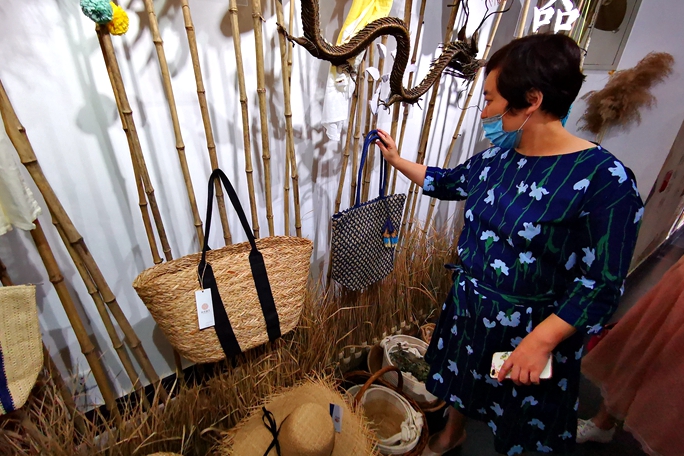History in bite-sized morsels
A TV documentary showcasing rare Chinese artifacts is gaining wide popularity. Li Yingxue and Lin Qi report.
A documentary series called If National Treasures Could Talk is making waves with its bite-sized episodes helping viewers to learn more about China's rich history.
The documentary has received good reviews since its producer, China Central Television, began to air the first season of 25 episodes on Jan 1.
There will be 100 episodes over four seasons. And the first season is now being re-broadcast and can also be viewed online.
Each episode of five minutes concentrates on one object, and also mentions other items bearing similar motifs or having similar cultural implications.
The featured artifacts are from more than 16 museums and cultural institutions across the country.
The documentary is popular with all ages, but especially with the young.
It highlights the connections between artifacts and modern life and the universal values that are embodied by these objects, rather than delivering lectures on history and archaeology.
Director Xu Huan says one of the aims of the series is to focus on the human spirit which is at the heart of Chinese cultural traditions.
Below is a snapshot of some of the artifacts showcased in the series.
Human Head Pottery Jar
Collection: Banpo Museum, Xi'an
Period: Neolithic era
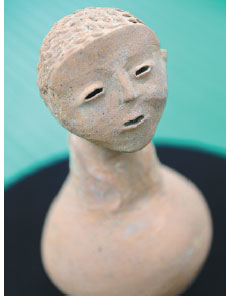
This head-shaped red clay jar dates from 6,000 to 6,500 years ago. It was a product of the Yangshao Culture that existed extensively along the Yellow River in China, made at the dawn of the Neolithic era, when humans began to polish stone, domesticate animals, farm and form tribes.
It's hard to tell the gender of the figure, but the up-turned lips suggest the innocence of a child. The jar's wide, round belly is also suggestive of the plumpness of a woman's form, and hints at her reproductive capability.
On the back is a spout, through which liquid could be poured inside. The eyes and mouth serve as outlets. They seem improbably narrow, but this may indicate that the jar served some special purpose.
When liquid flows out through the eyes, it resembles tears, perhaps telling the pain of childbirth.
Jiahu Bone Flute
Collection: Henan Provincial Museu
Period: Neolithic era
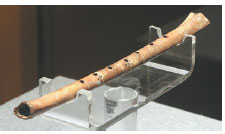
Some 9,000 years ago, a crane died. The carcass was collected by some villagers. Seeing this, the nearby cranes began a mournful wailing.
The villagers extracted the dead crane's wing bone, and carved it into a basic musical instrument.
The finger holes are uneven, and the carving around the mouthpiece is a little careless. But this simple instrument, the fruit of ancient creativity, has been continuously improved upon, and has evolved into the sophisticated flute we know today.
Musician Ding Xiaokui owns a copy of the crane bone flute.
The original, made between 7,800 and 9,000 years ago, was unearthed at the Jiahu Neolithic Site in Henan province. It was one of more than 20 such flutes found there in 1986 and 1987. They are the oldest musical instruments discovered in China.
The first bone flutes may have been used by hunters to mimic a bird's cry. Later, they may have provided music for celebrating a successful hunt. With time, as aesthetic appreciation became more developed, people may have demanded more complex music.
At Jiahu, the development from the older five-holed flutes to the later flutes with seven or eight holes, reveals how civilization progressed.
There used to be a widespread belief that traditional Chinese music had only five tones. The seven-tone scale, it was thought, was introduced from abroad. But the seven-holed bone flutes found at Jiahu have changed our understanding of China's ancient music.
Eagle-Shaped Pottery Ding
Collection: National Museum of China
Period: Neolithic era
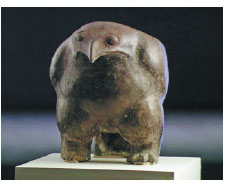
Pottery is the art of bringing clay to life. Thrown, kneaded, fired ...Through a series of hardships, the clay is reborn as pottery, reincarnated in every manner of shape. Here, the clay is given life as a ding - a three-legged vessel.
This ding in the form of an eagle is among China's most unusual pieces of ancient pottery. It's 6,000 years old, originating in the Neolithic Yangshao Culture.
Most of the painted pottery vessels produced by the Yangshao Culture were for daily use. The eagle-shaped ding is the only piece from that period that's in the shape of a bird.
What was its purpose? Perhaps to store water, or grain? Or perhaps it was used in sacrificial rites? But why was it given the form of a bird? Such questions add to the fascination the ding evokes.
What it does tell us is that 6,000 years ago Chinese people were capable of integrating practicality and design into their utensils.
Longshan Eggshell Black Pottery Cup
Collection: Shandong Provincial Institute of Cultural Relics and Archaeology
Period: Neolithic era

Some 4,000 years ago, on the banks of the Yellow River, the Longshan Culture brought the most rustic material and the most sophisticated craftsmanship together. Very few of these thin-sided black pottery cups have ever been unearthed.
Eggshell black pottery cups in various shapes have been found, suggesting that they were not part of a single batch.
The sophisticated manufacturing techniques were unique for their time. Even with the use of modern technology, it's hard to reproduce the extreme thinness of the original.
Pottery this thin will easily shatter on a fast-spinning wheel. Such small vessels place high demands on the wheel's precision and stability.
No kiln site associated with the time and place of these vessels' manufacture has been found, so we do not know what equipment was used 4,000 years ago.
Eggshell pottery was made from the fine silt deposited in rivers and lakes. Washing it and removing the impurities rendered this basic material strong enough to be made into thin but durable pottery.
The temperature in the kiln and the length of firing determined each vessel's fate.
The ancient potters used a unique sealed firing technique that allowed carbon to infiltrate the pores of the pottery. This produced a completely black surface, which was then glazed.
Hongshan Culture C-Shaped Jade Dragon
Collection: Ongniud Banner Museum
Period: Neolithic era
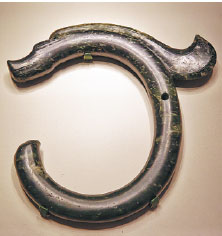
This mysterious work of jade art was discovered in Ongniud Banner in Chifeng, Inner Mongolia autonomous region. The nose is upturned and the eyes slightly convex. The mane gives the impression of a creature in flight. The design is simple and elegant; the jade, fine and smooth.
A similar jade piece was discovered in the village of Sanxing Tala in Chifeng. Known as the "First Dragon of China", it is regarded as the archetypal ancient depiction of a dragon. Both jade dragons were discovered near the city of Chifeng. It was here, in the Liaohe River Basin that the Hongshan Culture originated around 5,000 years ago.
The image of the jade dragon-boar has become a symbol of the Hongshan Culture.
Yet, the boar and dragon-shaped pottery of Hongshan is predated by that of the Xinglongwa (6200-5400 BC), a Neolithic culture in northeastern China. And images of dragons and tigers made from shells have been found in graves of the Yangshao Culture.
These cultures flourished in areas geographically far apart. Yet all three present a common image of the dragon, as a combination of parts of several different creatures.
The dragon is the symbol of the Chinese nation: Every aspect of the life of every Chinese person is like a scale on the dragon's body. Together, these scales shape Chinese civilization.
The curled jade rings resembling a baby in the womb, appear to be the earliest form of a dragon.
Contact the writers through liyingxue@chinadaily.com.cn
|
Crew members of If National Treasures Could Talk work on the production of the TV documentary. Photos provided to China Daily |
(China Daily 02/23/2018 page19)


 Shandong Culture and Tourism Consumption Season
Shandong Culture and Tourism Consumption Season Culture, tourism sectors pick up in Shandong as epidemic wanes
Culture, tourism sectors pick up in Shandong as epidemic wanes